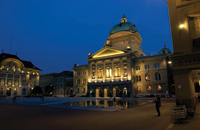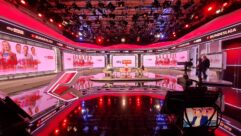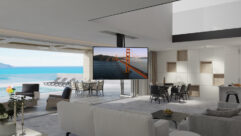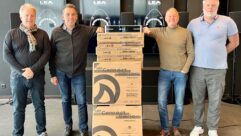

Installation Spotlight: The Federal Palace, Bern, Switzerland
Nov 9, 2009 4:48 PM
To bring the Federal Palace in Bern, Switzerland, into the 21st centery, modern AV technology was integrated within the 115-year-old structure so as not to dissrupt the aesthetics of the historical space. Primary to the retrofit was adding sound reinforcement to the National Council Hall and an audioconferencing system to the delegate conference rooms.
The Federal Palace in Bern, Switzerland, provides a superlative setting for the Federal Assembly of Switzerland and the Swiss Federal Council. Designed by architect Hans Wilhelm Auer, the palatial sandstone edifice was constructed over a period of eight years from 1894 to 1902. While its classic façade appears unchanged since the day it was completed, a number of technological upgrades have been incorporated to subtly but effectively bring the building into the 21st century.
Related Links

Installation Profile: Shedding Light on Franklin
Michael Mountjoy is the computer specialist for the Franklin Institute Science Museum in Philadelphia, and he’s also an amateur climber. His skills with…

The Buzz: Installation Spotlight: First United Methodist Church, Thomasville, Ga.
Few acoustic challenges are greater than the issue of designing adequate sound for historical structures during retrofit or upgrade jobs particularly…

The Buzz: Installation Spotlight: Audio Circus
The Mertz Theatre is well-known in the Sarasota, Fla., area and to anyone who has witnessed a performance in the historic facility…
In 2006, after more than 100 years of continuous service, work began on the first major renovation of this historic structure, directed by general planner Aebi and Vincent Architekten SIA AG on behalf of the awarding authority, Bundesamt für Bauten und Logistik. The mandate of the design and reconstruction team was to integrate modern technology within a faithful restoration of the original building. Their credo: “In altem Glanz erstrahlen“—gleaming in vintage splendour.
National Council Hall
The National Council Hall is distinguished by a large wall painting by Charles Giron depicting the Ruetli Meadow on Lake Lucerne where, according to legend, the Swiss Confederation was founded in 1291. Standing beside this masterwork is a statue of storied Swiss hero William Tell.
The National Council Hall has three distinctive zones that required sound reinforcement: the main hall, the stage area (with a presenter position and seats for chairpersons, vote counters, recorders, and clerks), and the balcony (for visitors and press).
With an office in Basel, Switzerland, WSDG was engaged to perform three tasks: develop a study and analysis of the installed electro-acoustical systems, deliver a formal recommendation for the upgrade or replacement the existing systems, and, following the installation, perform final acoustical measurements and a complete calibration of the new systems.
WSDG project manager Thomas Wenger and project engineer Gabriel Hauser began the assignment with a detailed analysis of the existing systems. They determined that the head end of the system—high-quality microphones and a highly integrated analog mixing desk—remained functional and had a substantial life expectancy. The loudspeaker systems, although originally well-designed, were deemed inadequate. Their positioning in the room coupled with their limited directivity control indicated that they should be replaced. Using advanced acoustical computer simulation techniques including full virtual 3D modelling and auralization of the space in CATT-Acoustic, a series of upgrade options was developed.
As primary criteria for the sound system, WSDG required that due to the room acoustics (RT60 times up to 2.5 seconds) the loudspeakers should offer very controlled directivity and high speech intelligibility for all 250 seats, and that the high-performance cabinets should also be compact and with extremely low visual impact.
After consultations with the historic building conservation authorities, installer Kilchenmann AG was able to fulfill WSDG’s design concept. Seven Nexo Geo S805 cabinets were used on each side of the large wall painting that dominates the chamber. The loudspeaker modules were fitted into purpose-built box frames with crossbars at the back, a WSDG concept executed primarily for cosmetic purposes but which also reduced the impact of fixing on the historic mural. Though they do not attract attention to themselves, the loudspeakers and other technology elements are clearly visible and appear entirely appropriate and at home in the setting.
Installation Spotlight: The Federal Palace, Bern, Switzerland
Nov 9, 2009 4:48 PM

The National Council Hall has three zones that required audio reinforcement: the main hall, the stage area, and the balcony. Using advanced acoustical computer simulation techniques that included 3D modelling and auralization of the space, WSDG determined the system should offer very controlled directivity and high speech intelligibility. The installed system includes seven Nexo Geo S805 cabinets mounted on each side of a large painting, Stoll Audio Custom
Picoline mini line-arrays with Lab.grubben amps address the stage, and more Picoline loudspeakers for the
balacony.
Due to acoustical feedback issues, the orientation of the stage and the chairperson’s position, it was not possible to cover that area with the main loudspeaker system. To address this issue, WSDG specified a separate Stoll Audio Custom Picoline mini line-array loudspeaker system using 1in. full-range driver units, also powered by 26 Lab.gruppen amplifiers. This custom designed system was installed locally on top of the vintage table tops, and it fully ameliorates the situation. Noted for their diminutive size and sound quality, the Picoline loudspeakers were also used for sound reinforcement in the balcony areas.
“This is a protected historic building, and it was not possible to add massive acoustic treatments, so it was very important to have a directive system,” Wenger says. “Acoustical measurements of speech intelligibility (among others) have been undertaken, and they nicely show the qualities of the upgraded system in comparison to the original one. The results are consistent with the simulations performed with CATT-Acoustic. Everyone is quite pleased.”

The Delegates conference rooms were updated with Sony video projectors and Marantz removable digital storage devices to archive
audio for transcription and translation. The most complex of these rooms have extensive AKG audioconference system that include microphones at all delegate positions and full simultaneous translating facilites for the three official Swiss languages: German, French, and Italian.
Delegates conference rooms
In addition to the National Council Hall, the Parliament Building also offers extensive conference and meeting facilities for the parliamentary delegates, which are organized by a number of committees and work groups.
In the course of the building’s renovation, all media systems in these spaces were updated as well. A basic infrastructural component, and therefore implemented in all rooms, is the option to record any and all meetings for transcription, translation, and archiving onto a removable Marantz digital storage device. For security and privacy reasons, these systems are managed and operated by special personnel. Most meetings are equipped with projectors and projection screens, and the most complex rooms have an extensive AKG audioconference system including microphones at all delegates’ positions and full simultaneous translating facilities for the three official Swiss languages—German, French, and Italian. All media systems are controlled by a uniformly designed AMX touchpanel so that anyone familiar with operating room A can similarly operate room B or C.










